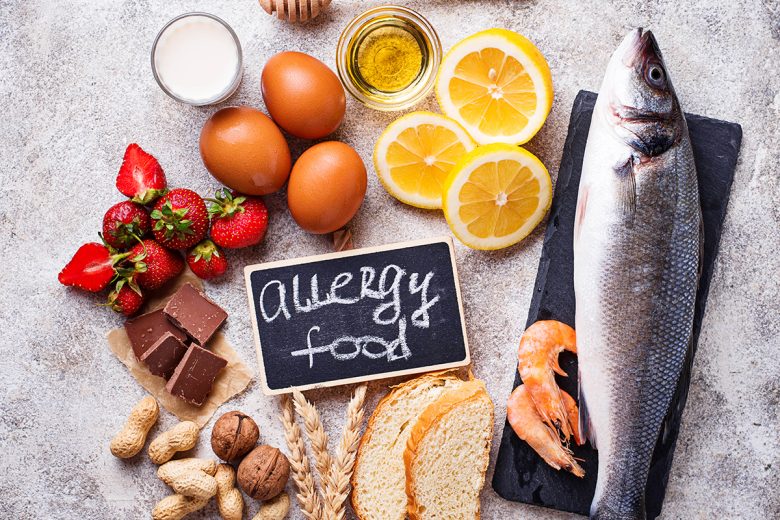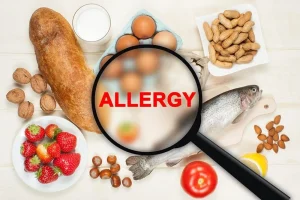Many people worry about food allergies, both as children and adults. They can be anything from a mild discomfort to a potentially fatal reaction. But what exactly makes people allergic to food? The immune system is at the center of these reactions. This article will explain how your immune system is a key part of how food allergies develop. This will help you understand what happens in your body when an allergic reaction occurs.
1. What Are Food Allergies?
Before we talk about the immune system’s role, it’s important to explain what a food allergy is. When you eat a certain food, your immune system reacts adversely, which is called a food allergy. When a person with a food allergy eats, touches, or even inhales the food that causes the allergy, the immune system reacts as if it were fighting a harmful pathogen, such as a virus or bacteria. If this happens too much, it can cause symptoms such as swelling, hives, digestive problems, and in the worst cases, anaphylaxis.
2. The Immune System
Your immune system is the body’s natural way of protecting itself. It finds harmful invaders, such as viruses, bacteria, and toxins, and fights them off. The immune system is made up of many different parts, such as white blood cells, antibodies, and other molecules designed to find and destroy foreign invaders.
The immune system helps keep us healthy by fighting off infection and disease. On the other hand, when someone is allergic to a food, it sees harmless proteins in the food as a threat. The symptoms we think of as food allergies stem from this mistake.
3. How Does the Immune System Misidentify Food?
When you eat food, your digestive system breaks it down into fats, proteins, and carbohydrates. For people who are allergic to certain foods, their immune system mistakes certain proteins for harmful invaders. These proteins are called allergens, which cause the immune system to react.
For example, for someone who is allergic to peanuts, the immune system knows that peanut protein is harmful to them. The immune system produces special proteins called immunoglobulin E (IgE) that are able to recognize and attack the allergen when it encounters it again.
4. The Release of Histamine and Its Effects
An important component of an allergic reaction is histamine. It dilates blood vessels, swells and turns the skin red, and when it travels through the respiratory system, it narrows the airways, making it difficult to breathe. This is why people with severe food allergies often experience symptoms such as wheezing or difficulty breathing.
Histamine can make you feel nauseous, vomit, or have diarrhea. Histamine can also cause skin reactions like hives or eczema, which are common in people with food allergies.
5. Common Allergens in Food
Food allergies can occur with almost any food, but some foods are more likely to cause food allergies than others. Most food allergies are caused by these eight allergens, often referred to as the “Big Eight”:
- Peanuts
- Foods that come from trees, such as cashews, walnuts, and almonds
- Milk
- Eggs
- Fish
- Shelled seafood, such as lobster, crab, and shrimp
- Soy
- Wheat
Each of these foods can cause an immune response in people who are allergic to these proteins.
6. Diagnosing Food Allergies
To get a diagnosis, you need to understand how the immune system affects food allergies. If you think you might have a food allergy, be sure to talk to your doctor. To find out which foods cause an allergic reaction, they may perform a skin prick test, an IgE antibody blood test, or an oral food challenge.
A skin prick test places a small amount of a possible allergen on your skin and causes a mild sting. If a red, itchy bump appears, it could mean you have an allergy. Blood tests check how much IgE antibodies are present against certain allergens. As part of an oral food challenge, patients are given small amounts of the suspected food and watched by a doctor to see if they react.
7. Managing Food Allergies
If you have a food allergy, the best way to manage it is to avoid the source of the allergy. This may mean reading food labels carefully, asking about ingredients when eating out, and carrying antihistamines or epinephrine auto-injectors (like EpiPens) with you for emergencies.
For kids with food allergies, managing them often means creating an allergy action plan for daycare or school so that staff members know what the allergy is and what to do in an emergency.
8. New Ways to Treat Food Allergies
Scientists are always looking for new ways to help people with food allergies. Oral immunotherapy is an interesting area of research. In this approach, patients are given small amounts of the allergen, which slowly builds up over time. Over time, this can help the immune system become less sensitive to the allergen, which can reduce the severity of the reaction or even eliminate the allergy altogether.
Another possible treatment is the use of monoclonal antibodies that target and block IgE antibodies. These antibodies prevent IgE antibodies from binding to mast cells and basophils. These treatments are still being researched, but they offer hope for people with severe food allergies.
Conclusion
Food allergies are more than just pain; complex interactions between your immune system and proteins in certain foods cause them. To manage these conditions effectively, you need to understand how your immune system responds to allergens. Understanding how the immune system affects food allergies can help people take charge of their health and well-being, such as by avoiding allergy-causing foods, preparing for emergencies, or using new treatments.
FAQs
1. What is a food allergy?
If your immune system does not respond properly to certain proteins in food, you may have a food allergy. When someone with a food allergy eats or comes into contact with an allergen, their immune system interprets the allergen as harmful and reacts, with reactions ranging from mild symptoms to life-threatening anaphylaxis.
2. What part of the immune system makes people allergic to food?
When certain food proteins (allergens) are detected, the immune system produces antibodies called immunoglobulin E (IgE). When the allergen is detected, these IgE antibodies cause immune cells to release histamine and other chemicals, causing symptoms such as hives, swelling or difficulty breathing.
3. What foods are most likely to cause allergies?
Most food allergies are caused by peanuts, tree nuts, milk, eggs, fish, shellfish, soy and wheat. These are the “big eight” allergens.
4. What role does histamine play in food allergies?
Histamine is a chemical released by immune cells during an allergic reaction. It causes the same symptoms that people with food allergies often experience, such as redness, swelling, itching, difficulty breathing, and stomach problems.
5. What does allergic reaction mean?
Anaphylaxis is a severe allergic reaction that can be fatal. It can affect many parts of the body. Some symptoms include difficulty breathing, a rapid drop in blood pressure, and throat and tongue swelling. The patient should be treated immediately with epinephrine.




